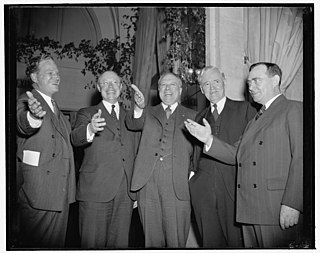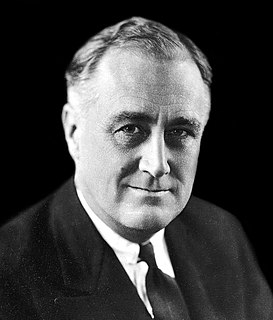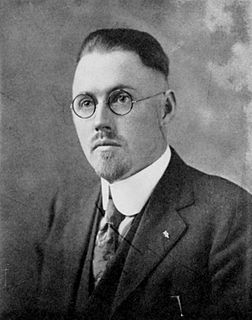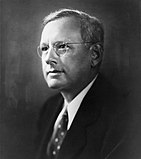
The United States presidential election of 1936 was the thirty-eighth quadrennial presidential election, held on Tuesday, November 3, 1936. In the midst of the Great Depression, incumbent Democratic President Franklin D. Roosevelt defeated Republican Governor Alf Landon of Kansas. Roosevelt won the highest share of the popular and electoral vote since the largely uncontested 1820 election. The sweeping victory consolidated the New Deal Coalition in control of the Fifth Party System.

Nancy Landon Kassebaum Baker is an American politician who represented the State of Kansas in the United States Senate from 1978 to 1997. She is the daughter of Alf Landon, who was Governor of Kansas from 1933 to 1937 and the 1936 Republican nominee for president, and the widow of former Senator and diplomat Howard Baker. She was the first woman ever elected to a full term in the Senate without her husband having previously served in Congress.

John Daniel Miller Hamilton was a Republican politician from the U.S. state of Kansas.

The 1936 Republican National Convention was held June 9–12 at the Public Auditorium in Cleveland, Ohio. It nominated Governor Alfred Landon of Kansas for President and Frank Knox of Illinois for Vice President.

Walter Augustus Huxman was the 27th Governor of Kansas and a United States Circuit Judge of the United States Court of Appeals for the Tenth Circuit.

The 1936 United States presidential election in New York took place on November 3, 1936. All contemporary 48 states were part of the 1936 United States presidential election. New York voters chose 47 electors to the Electoral College, which selected the president and vice president.

The 1936 United States presidential election in Massachusetts took place on November 3, 1936, as part of the 1936 United States presidential election, which was held throughout all contemporary 48 states. Voters chose seventeen representatives, or electors to the Electoral College, who voted for president and vice president.

The 1936 United States presidential election in Vermont took place on November 3, 1936, as part of the 1936 United States Presidential Election which was held throughout all contemporary 48 states. Voters chose three representatives, or electors to the Electoral College, who voted for president and vice president.

The 1936 Republican presidential primaries were the selection process by which voters of the Republican Party chose its nominee for President of the United States in the 1936 U.S. presidential election. The nominee was selected through a series of primary elections and caucuses culminating in the 1936 Republican National Convention held from June 9 to June 12, 1936, in Cleveland, Ohio.

The 1936 United States presidential election in New Jersey took place on November 3, 1936. All contemporary 48 states were part of the 1936 United States presidential election. New Jersey voters chose 16 electors to the Electoral College, which selected the president and vice president.

The 1936 United States presidential election in Virginia took place on November 3, 1936. Voters chose eleven representatives, or electors to the Electoral College, who voted for president and vice president.

The 1936 United States presidential election in Minnesota took place on November 3, 1936, in Minnesota as part of the 1936 United States presidential election.

The 1930 Kansas gubernatorial election took place on November 4, 1930. Harry H. Woodring was elected Governor of Kansas, becoming only the fourth member of the Democratic Party to hold the position in state history. He won with only 34.96% of the vote, with the remainder being split between Republican candidate Frank Haucke and independent write-in candidate John R. Brinkley. Woodring's final margin of victory over Haucke was just 251 votes, or 0.04 percent. The incumbent governor, Republican Clyde M. Reed, did not stand for re-election.

The 1936 United States presidential election in Maine was held on November 3, 1936 as part of the 1936 United States presidential election. The state voters chose five electors to the Electoral College, who voted for president and vice president.

The 1936 United States presidential election in South Carolina was held on November 3, 1936. The state voters chose eight electors to the Electoral College, who voted for president and vice president.

The 1936 United States presidential election in Wyoming took place on November 3, 1936, as part of the 1936 United States presidential election. Wyoming voters chose three representatives, or electors, to the Electoral College, who voted for president and vice president.

The 1936 United States presidential election in Kansas took place on November 3, 1936 as part of the concurrent United States presidential election held in all forty-eight contemporary states. Kansas voters chose nine electors, or representatives to the Electoral College, who voted for President and Vice-President.















